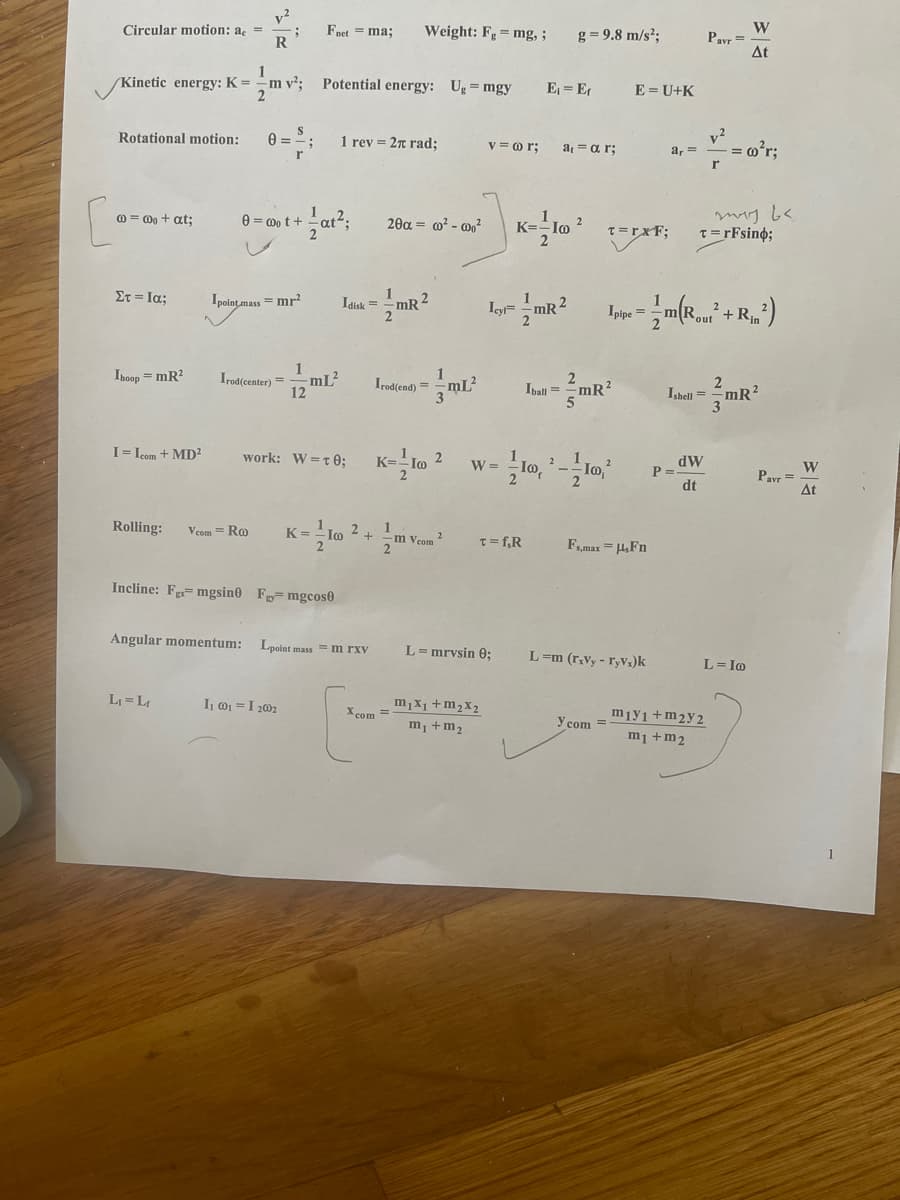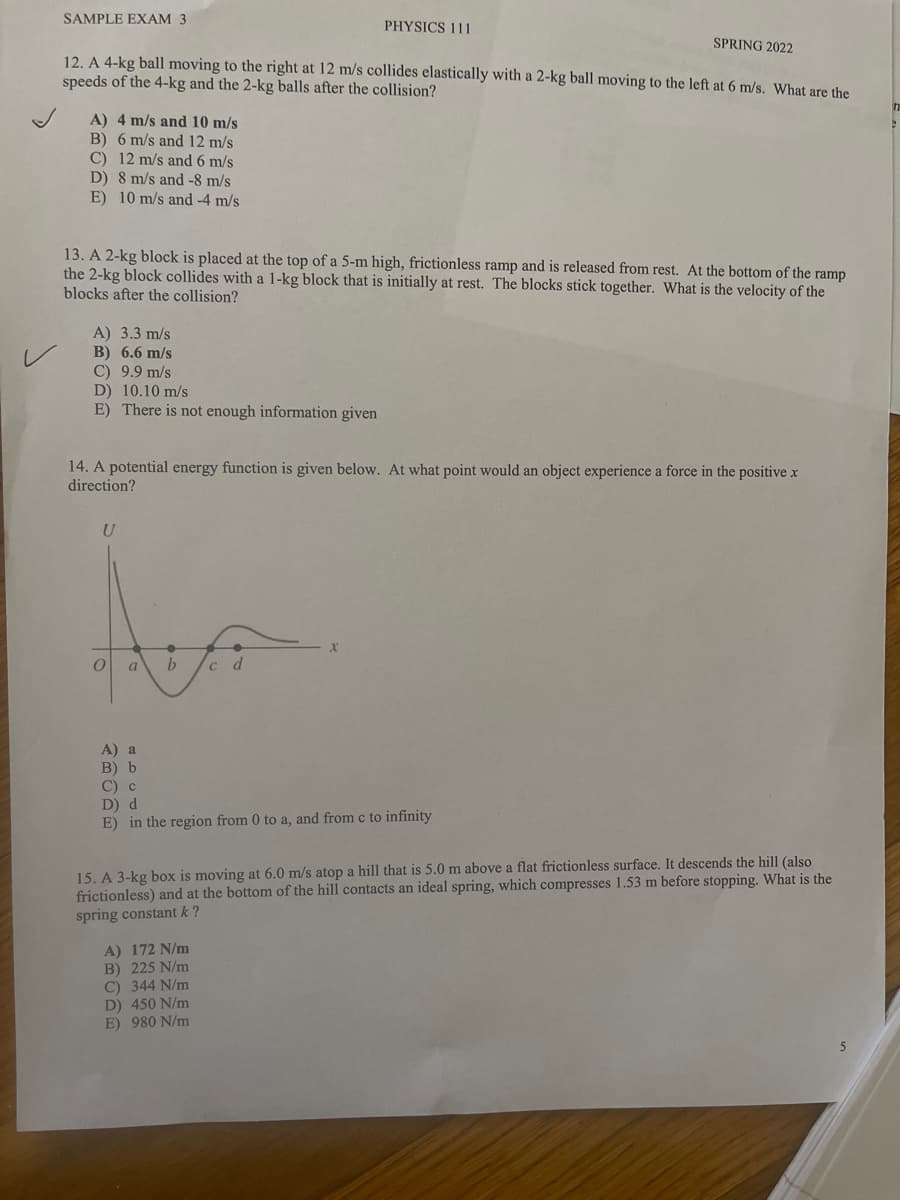College Physics
11th Edition
ISBN:9781305952300
Author:Raymond A. Serway, Chris Vuille
Publisher:Raymond A. Serway, Chris Vuille
Chapter6: Momentum, Impulse, And Collisions
Section: Chapter Questions
Problem 63AP: A 2.0-g particle moving at 8.0 m/s makes a perfectly elastic head-on collision with a resting 1.0-g...
Related questions
Question
13 please using by this formula sheet easy way to explain

Transcribed Image Text:v2
Circular motion: a =
R
W
Pavr =
At
Fast = ma;
Weight: F = mg, ;
g = 9.8 m/s²;
1
(Kinetic energy: K = -m v²;
2
Potential energy: Ug = mgy
E = E
E = U+K
Rotational motion:
1 rev = 2n rad;
V = 0r;
= m?r;
at = ar;
a, =
0 = 0o + at;
0 = 0o t+
20a = 0² - mo²
K=-To t =rFsing;
T =rxF;
Στ-Ια;
Ipointmass = mr?
1
Icy=
2 mR 2
Idisk =
mR 2
1
+Rin
Ihoop = mR?
1
Irod(center) =
1
Ired(end) = mL
3
2
Iball = mR?
2
Ishell = mR?
3
12 mL?
work: W=t0; K--lo ?
I= Icom + MD?
P- dW
dt
2
W =
W
Pavr =
At
Rolling:
Veom = Ro
K =
2
m Veom 2
2
T= f,R
F,max = H,Fn
Incline: F=mgsin0 F=mgcos0
Angular momentum;
Lpolnt mass =m rxv
L=mrvsin 0;
L=m (r,vy - ryV,)k
L= Io
LI = Lr
I, 01 =I 202
m,X1+m2X2
X com =
miyi+m2y2
m, +m2
y com =
m1 +m2

Transcribed Image Text:SAMPLE EXAM 3
PHYSICS 111
SPRING 2022
12. A 4-kg ball moving to the right at 12 m/s collides elastically with a 2-kg ball moving to the left at 6 m/s. What are the
speeds of the 4-kg and the 2-kg balls after the collision?
A) 4 m/s and 10 m/s
B) 6 m/s and 12 m/s
C) 12 m/s and 6 m/s
D) 8 m/s and -8 m/s
E) 10 m/s and -4 m/s
13. A 2-kg block is placed at the top of a 5-m high, frictionless ramp and is released from rest. At the bottom of the ramp
the 2-kg block collides with a 1-kg block that is initially at rest. The blocks stick together. What is the velocity of the
blocks after the collision?
A) 3.3 m/s
B) 6.6 m/s
C) 9.9 m/s
D) 10.10 m/s
E) There is not enough information given
14. A potential energy function is given below. At what point would an object experience a force in the positive x
direction?
a
c d
A) a
B) b
С) с
D) d
E) in the region from 0 to a, and from c to infinity
15. A 3-kg box is moving at 6.0 m/s atop a hill that is 5.0 m above a flat frictionless surface. It descends the hill (also
frictionless) and at the bottom of the hill contacts an ideal spring, which compresses 1.53 m before stopping. What is the
spring constant k ?
A) 172 N/m
B) 225 N/m
C) 344 N/m
D) 450 N/m
E) 980 N/m
Expert Solution
This question has been solved!
Explore an expertly crafted, step-by-step solution for a thorough understanding of key concepts.
Step by step
Solved in 3 steps with 2 images

Knowledge Booster
Learn more about
Need a deep-dive on the concept behind this application? Look no further. Learn more about this topic, physics and related others by exploring similar questions and additional content below.Recommended textbooks for you

College Physics
Physics
ISBN:
9781305952300
Author:
Raymond A. Serway, Chris Vuille
Publisher:
Cengage Learning

Physics for Scientists and Engineers, Technology …
Physics
ISBN:
9781305116399
Author:
Raymond A. Serway, John W. Jewett
Publisher:
Cengage Learning

College Physics
Physics
ISBN:
9781285737027
Author:
Raymond A. Serway, Chris Vuille
Publisher:
Cengage Learning

College Physics
Physics
ISBN:
9781305952300
Author:
Raymond A. Serway, Chris Vuille
Publisher:
Cengage Learning

Physics for Scientists and Engineers, Technology …
Physics
ISBN:
9781305116399
Author:
Raymond A. Serway, John W. Jewett
Publisher:
Cengage Learning

College Physics
Physics
ISBN:
9781285737027
Author:
Raymond A. Serway, Chris Vuille
Publisher:
Cengage Learning

Physics for Scientists and Engineers
Physics
ISBN:
9781337553278
Author:
Raymond A. Serway, John W. Jewett
Publisher:
Cengage Learning

Physics for Scientists and Engineers with Modern …
Physics
ISBN:
9781337553292
Author:
Raymond A. Serway, John W. Jewett
Publisher:
Cengage Learning

Principles of Physics: A Calculus-Based Text
Physics
ISBN:
9781133104261
Author:
Raymond A. Serway, John W. Jewett
Publisher:
Cengage Learning